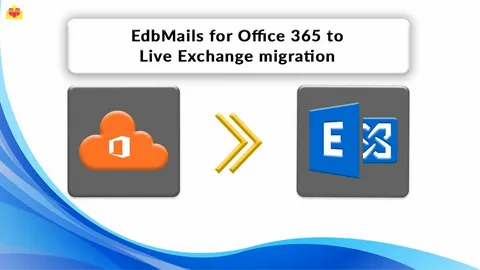While migrating from Exchange 2016 to 2019 is essential for many businesses, the process is not without its challenges. In this article, we will explore the common challenges faced during the migration process and how EdbMails effectively addresses them.
Common Challenges in Exchange Migration
- Compatibility Issues
Ensuring that all applications and services are compatible with Exchange 2019 can be difficult. Organizations may face challenges with legacy applications that do not support the new version.
- Downtime
Minimizing downtime is a major concern during any migration. Extended periods of downtime can disrupt business operations and lead to productivity losses.
- Data Integrity
The risk of data loss or corruption during migration is significant. Ensuring that all data is accurately transferred without any loss is critical for maintaining business continuity.
- Complexity in Mailbox Migration
Migrating large numbers of mailboxes, public folders, and other data can be a complex process. Administrators often struggle with managing the migration of numerous mailboxes simultaneously.
How EdbMails Overcomes These Challenges
- Zero Downtime
EdbMails allows users to access their mailboxes during migration, significantly reducing the impact on business operations. This zero-downtime feature ensures that employees can continue their work without interruptions, maintaining productivity throughout the migration process .
- Comprehensive Compatibility Checks
EdbMails performs compatibility checks to identify potential issues before the migration begins. This proactive approach ensures a smooth transition to Exchange 2019, allowing organizations to address compatibility concerns in advance .
- Robust Data Integrity Measures
EdbMails employs encryption and verification processes to ensure that data remains secure and intact throughout the migration. The tool guarantees that all emails, attachments, and other data are accurately transferred without loss or corruption, providing peace of mind to administrators .
- Scalability
EdbMails is designed to handle the migration of thousands of mailboxes without any impact on performance or data loss. Its scalable architecture allows organizations to migrate large volumes of data efficiently, simplifying the overall migration process .
Migrating from Exchange 2016 to 2019 with EdbMails: A Comprehensive Guide
Upgrading from Exchange 2016 to Exchange 2019 enhances email security, performance, and reliability for organizations. With EdbMails Exchange Migration Tool, this process becomes structured and efficient. Here’s a streamlined guide for a successful migration:
Step 1: Download and Install EdbMails
- Download: Visit the EdbMails website and download the Exchange Migration Tool.
- Installation: Install it on a system that can access both your Exchange 2016 (source) and Exchange 2019 (target) servers. Complete the setup by following the on-screen instructions.
Step 2: Launch and Log In
- Launch the Application: After installation, open EdbMails.
- Sign In: Use your EdbMails credentials to log in and access the main interface.
Step 3: Choose Your Migration Type
- Select Migration Mode: From the dashboard, click on ‘Live Exchange Migration’ to start the migration process.
Step 4: Connect to the Source Exchange 2016 Server
- Connection Settings: Opt for ‘Connect using Global Admin User’, ensuring you have Global Administrator rights on the Exchange 2016 server.
- Load Mailboxes: EdbMails will automatically load all mailboxes. Alternatively, you can use a CSV file to select specific mailboxes.
Step 5: Select Mailboxes to Migrate
- Pick Mailboxes: From the displayed list, select the mailboxes you need to migrate to Exchange 2019. You can choose individual or multiple mailboxes.
Step 6: Connect to the Target Exchange 2019 Server
- Target Setup: Click ‘Migrate to Live Exchange’ and configure the connection to the Exchange 2019 server.
Step 7: Map Source to Target Mailboxes
- Automatic Mapping: EdbMails will attempt to map source mailboxes to target mailboxes automatically. Review the mappings.
- Manual Mapping: If required, manually adjust the mailbox mappings to ensure they match correctly.
Step 8: Begin the Migration Process
- Start Migration: After confirming the mailbox mappings, click ‘Migrate’ to initiate the migration.
- Monitor the Progress: Track the migration in real time. Detailed logs are available for review by clicking ‘View Log’.
Step 9: Complete Post-Migration Steps
- Update DNS: Modify your MX records to point incoming mail traffic to the Exchange 2019 server.
- Configure Settings: Adjust additional settings like permissions, security configurations, and services on the new server.
Step 10: Decommission the Exchange 2016 Server
- Validate Migration: Ensure all data and mailboxes have been migrated correctly.
- Uninstall and Decommission: Once confirmed, uninstall and retire the Exchange 2016 server from your environment.
Conclusion
Migrating from Exchange 2016 to 2019 presents several challenges, including compatibility issues, downtime, data integrity risks, and complexity in mailbox migration. However, EdbMails offers effective solutions to these challenges, ensuring a smooth and efficient migration process. With features such as zero downtime, comprehensive compatibility checks, robust data integrity measures, and scalability, EdbMails empowers organizations to transition to Exchange 2019 with confidence. By leveraging EdbMails, businesses can minimize disruptions, protect their data, and enhance their email infrastructure, positioning themselves for future growth and success.
Additionally, Sigsync Office 365 email signature service, another product from the same company, provides an excellent solution for managing email signatures and disclaimers within Office 365. With a wide array of professionally designed templates and an intuitive editor, Sigsync enhances branding efforts and ensures consistency across organizational communications.



